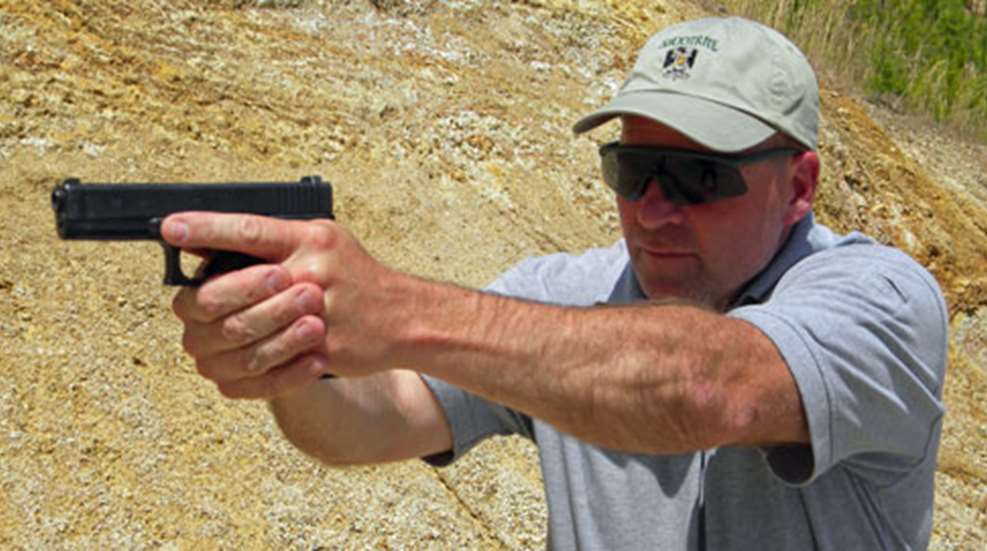
1/3/2013
Violent confrontations are usually sudden, dynamic and unpredictable. Avoidance and escape are always at the top of our list of responses, but when this isn’t possible an immediate defensive response is required that includes movement, communication, cover and, if needed, shooting.
The problem with self-defense fundamentals is that none of them are natural. Almost everything needed to fight effectively with firearms goes against our natural instincts. For example, our natural response to a threat, once we decide to fight, is to root to the ground. Communication under stress is also difficult because it consumes a large part of our brain’s resources. Practicing what and when to communicate is essential to overcome the lockjaw normally experienced. Finally, humans aren’t built to have explosions going off in our hands, even the controlled explosion of a firearm. An understanding of these fundamentals and plenty of practice are required to effectively use a firearm for self-defense.
Movement
Creating distance from the threat(s) greatly reduces the chance of injury regardless of the type of weapon, if any, with which your opponent(s) are armed. It’s likely there will be bystanders in the environment, so movement could be required to obtain a clear angle of attack on the target. Movement also allows us to avoid a threat’s line of attack, plus it puts them in a reactive mode. If when a threat charges, you suddenly start moving right, the threat has to assess your actions, create a response and redirect the attack. Most environments have objects that can be used for cover, so you also move to take advantage of cover and the protection it provides. As soon as possible you move to get to an exit or safer area.
Most shooters can move smoothly and shoot accurately, or move quickly and not fire, or at least not accurately. The situation determines the best response. Moving and shooting combines both physical and mental focus. Movement must be smooth, stable and in a manner that allows for maintaining physical balance. Falling down in a fight is not good as mental focus is lost when our physical balance gets upset. When you’re not shooting while moving you still have to maintain a stable platform, and be ready to respond to any additional dangers that may present themselves. Unfortunately, most shooting ranges won’t allow you to move and fire. Therefore practice shooting at the range and work on movement at home using a dummy gun.
Communication
Communication is one of the key tactical skills often overlooked during training and practice. The presence of a firearm and strong verbal commands diffuse a violent confrontation approximately 2.5 million times a year, and this is only the documented number. There is no telling how many of these types of situations are not recorded. When you have an armed partner, a husband and wife or multiple officers, communication is required to coordinate tactics and actions. Verbalizing your actions can also help you maintain mental focus.
Remember, communication is a two way street, an exchange of information. You talk to your dogs but you communicate with your wife. Simple, short and sweet communication works best. Use names in order to get someone’s attention, and then issue instructions. Even simple communication consumes a large part of our brain’s resources. In order to communicate under stress it’s necessary to practice in advance.
Cover
Get to cover as quickly as possible, preferably as soon as you spot potential trouble and before the physical confrontation begins. Cover provides protection against a threat. A large table can provide cover against a knife since the threat must be within arm’s reach. Cover that provides protection against firearms will need to be more substantial, something that will stop or redirect incoming rounds.
To take full advantage of cover there are a few fundamentals to apply, keeping in mind that there are exceptions to these principles. First, whenever possible create distance between you and your cover. Maintaining distance from cover is completely contrary to our natural instincts. The closer we hug to cover the safer we feel, but just the opposite is true. Distance greatly reduces the possibility of being injured by fragmentation and debris created when incoming rounds strike the cover object. Distance also opens up your field of view, allowing you to see more of what’s going on around you. Being visually oriented creatures, this is important. There’s much more to using cover properly than just getting behind it.
Keep in mind most objects in your environment offer a certain degree of protection, but might not be completely bulletproof. It doesn’t take that many pistol rounds, even fewer high-velocity rifle rounds, to punch a hole in a brick or concrete wall. Once you’re behind cover you should be looking for better cover, something that offers more protection, puts more distance between you and the threat(s) or gets you closer to an escape route. Also, while concealment doesn’t offer any protection don’t discount its value. If your adversaries don’t know where you are it reduces the chance of them launching an attack.
Marksmanship
You have to be able to apply the fundamentals of marksmanship—aim, hold, press and follow through—under any type of circumstance. The speed you can cycle through the fundamentals depends on the accuracy required for the shot. For a large, close target you can go fairly quickly and place the hits where needed. As the distance increases or target size decreases you have to be more precise, ensuring when you press the trigger it’s a good hit.
Defending against a lethal threat is problem solving at high speed. You have to constantly be thinking in order to make the threat react to you as opposed to simply reacting to what’s being done to you. When presented a problem, you have a small amount of time to come up with a solution and then execute those actions. In order to perform as necessary you have to consider what you’re going to do, what you’ll do if that doesn’t work, and still be ready for the unexpected, which occurs in fights with regularity.
To focus on the problem solving aspects of the conflict you must be able manipulate your firearm at a subconscious level. There’s no time to think about how to reload or clear a malfunction, it just has to happen. The same applies to moving, communicating and using cover.
These fundamental skills—movement, communication, using cover and shooting accurately under stress—are not things you can learn on your own. Reading or watching videos is good, but to blend these fighting skills into one package requires training under a qualified instructor. After that comes learning through practice and repetition to ingrain these skills at a subconscious level. Again: Functioning at the subconscious level frees the conscious mind to think about the fight.
Self-defense is more art than science. Your ‘artwork’ will be different from everyone else’s. Although the details of combat are unpredictable, these fundamental skills will come into play: Movement, communication, the use of cover and the possibility of employing your firearm. In addition to all this you have to be thinking. Train, practice and learn, and remember your ultimate tool is your mind. If you’re not thinking all, you’re doing is reacting, which is a hard way to win the fight. Be prepared, and force the threat to react to you. This is the path to victory.




































